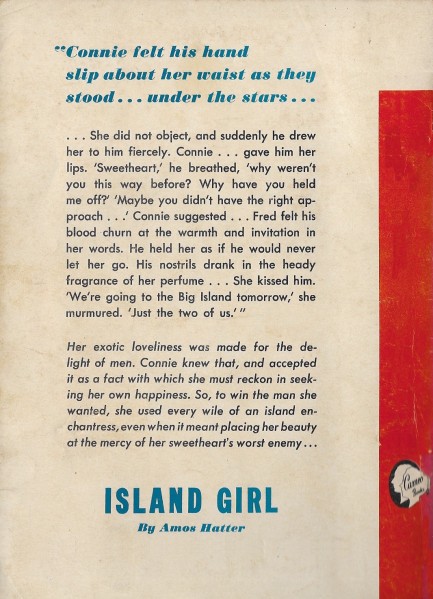 The day the sky cracked in half.  
There's been increased talk over the last few years about the weaponization of space, however that bridge was crossed a long, long time ago by the U.S. and Soviet Union, with the U.S. getting the ball rolling in 1958 with a series of tests secretly conducted over the South Atlantic Ocean. The above photos, which were made from Honolulu, Hawaii, and the one below made from a surveillance aircraft, and show the U.S. nuclear test known as Starfish Prime. It was one of five explosions comprising Operation Fishbowl, which itself was folded within the encompassing set of tests known as Operation Dominic. The detonation took place in space at an altitude of about 250 miles, and was launched from the North Pacific Ocean's Johnston Atoll atop a Thor ballistic missile. That was today in 1962.
 Every top notch private investigator knows the best clues are found in bed. 
We wanted to show you another poster painted by John Solie, who was responsible for numerous blaxploitation, sexploitation, and action promos, all executed at the extremely high level you see here with his one sheet for Stacey. His other notable efforts include those for The Arena, Star Crash, Hit Man, and Hollywood Boulevard. You can click his keywords at bottom to see everything we've shared from him.
Naturally we watched Stacey and it's a cheesy detective tale starring erstwhile Playboy centerfold Anne Randall, who plays a model-turned-private dick hired to investigate a rich woman's extended family before any of them are allowed to be included in her will. Randall arrives just in time for intrigue and murder. Private investigators need to possess a Class C license in order to legally take on clients. The C on Randall's license probably stands for “casual sex.”
Even so, there's not much here. The detective elements are uninspiring despite a noir style voiceover, and the sexual elements, even with Randall and co-star Anitra Ford in occasional undress, are not going to blow your skirt up. To put the overall nothingness of the movie in perspective, consider the fact that we couldn't find a copy with sharp enough resolution to make screenshots worthwhile, nor enough official production photos to make them worth sharing. That's how much of a historical afterthought it is.
In lieu of imagery you could use your imagination, but we recommend not bothering. Stacey resides at the low end of grindhouse cinema characterized by numerous bold and outrageous entries. In our opinion it's notable only for being the first exploitation effort by director Andy Sidaris, who would go on to helm boobalicious ’80s throwaways such as Malibu Express, Hard Ticket to Hawaii, and Savage Beach. Stacey premiered in the U.S. this month in 1973.
 Fangs for your service. 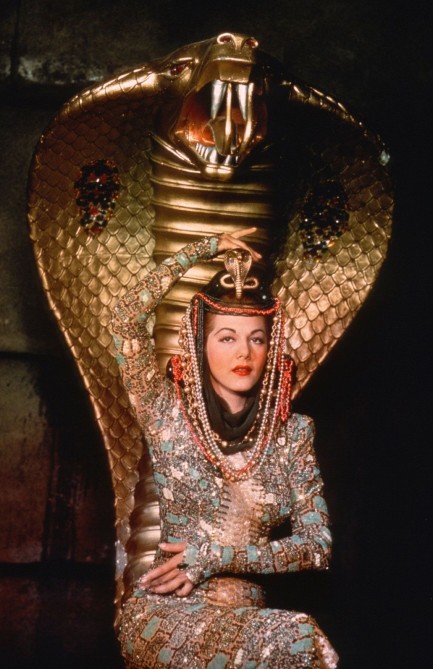
This promo image of Dominican actress Maria Montez in costume for her starring role in 1944's The Cobra Woman sells the movie for us. We'll definitely watch it—and hope it's better than the similarly named 1972 b-horror flick Night of the Cobra Woman. For that matter, we hope it's better than 1955's Cult of the Cobra. Our fingers are crossed. Montez was one of the top actresses in exotic escapist films, appearing in such fare as Ali Baba and the Forty Thieves, South of Tahiti, Moonlight in Hawaii, Sudan, Tangier, White Savage, Pirates of Monterrey, The Thief of Venice... you get the idea. She was still at the top of her globetrotting game when she was found dead in her bathtub in 1951 at age thirty-nine, but her legacy as a film star is assured—even if her movies were shot on Hollywood sound stages, she helped audiences travel the world.
 Any kind of work is good work. 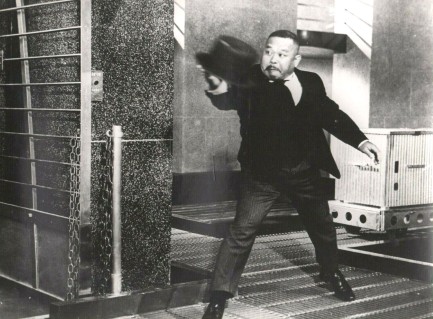
Probably needing no introduction, above, is Hawaii born actor Toshiyuki Sakata, who performed as Harold Sakata. We ran across this 1964 promo image on an auction site and had to share it. Sakata rose to fame initially as an Olympic weightlifter and professional wrestler, but was coaxed in front of the movie camera to play Oddjob in the film Goldfinger. He was one of Bond's most formidable foes, fighting with brute strength and his deadly top hat, which had a razor sharp steel brim that could take the head off a marble statue. Unfortunately, that same hat led to his character's demise when he was electrocuted inside Fort Knox. After that ugly death Sakata went on to amass more than thirty credits in cinema and television—a successful career by any measure. But he'll probably always be best known as Oddjob.
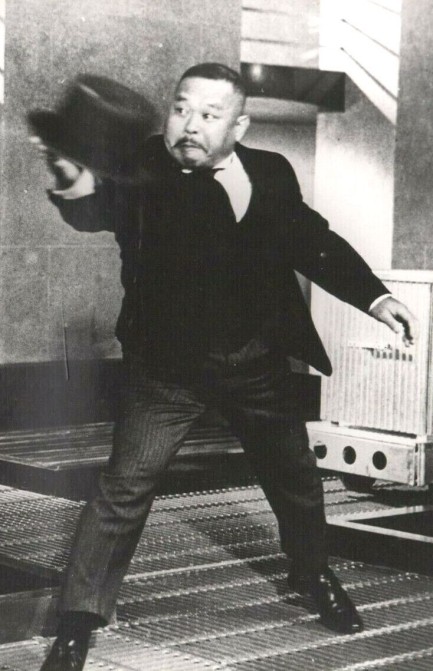 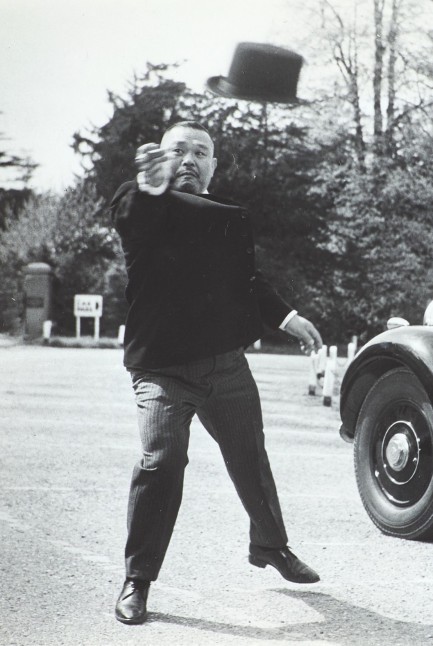
 He doesn't have a hook for a hand yet, but he's always practicing for that day. 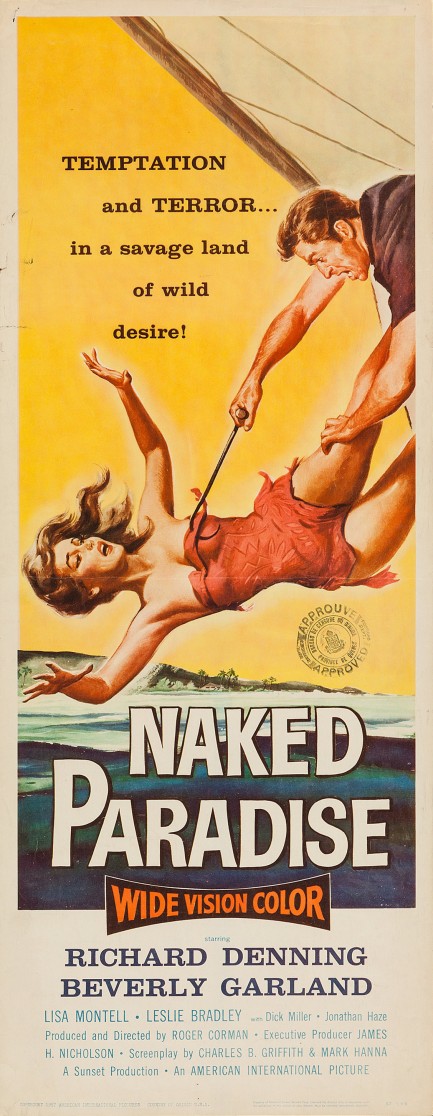
The first thing to know about Naked Paradise is that it's an early Roger Corman movie, made by Sunset Production and distributed through American International Pictures, companies he helped establish. Corman also directed, so it's safe to say he had near-total control of the movie on and off the set. While he's made some real stinkers over the years, by his standards Naked Paradise isn't terrible. That doesn't mean its good. It's still laughably dopey in parts, the type of movie you can riff on from start to finish, but narratively it hangs together reasonably well and a couple of the actors practice their craft with competence.
Plotwise, three criminals led by Leslie Bradley travel to Oahu disguised as pleasure cruisers to try lifting a massive pineapple and sugar cane plantation's payroll. Their escape is via the same method as their arrival, unbeknownst to their boatmates, who at first are too busy sunning themselves and romancing to realize there are three dangerous criminals in their midst. Tensions between the boat's captain Richard Denning and the crooks soon come to a frothing head when the lead heister and his arm candy Beverly Garland acrimoniously split from each other.
The group are then stuck together during a tropical storm, a plot turn which brings to mind Key Largo. In fact we can hear screenwriter Robert Wright Campbell's pitch to Corman: “You see, it's Key Largo, sandwiched on one side by deep backstory showing the audience why Johnny Rocco and his henchmen are on the run, and on the other by an extended aquatic climax.” That's exactly the movie Corman made, though doubtless done far more cheaply than Campbell ever envisioned.
Corman has a genius for conjuring final results that are better than their shoestring budgets should allow, and he certainly is an unparalleled wrangler of nascent talent. He's given opportunities to directors such as Coppola, Demme, Scorsese, and Ron Howard, and performers like Jane Fonda and William Shatner. If there's such as thing as a pulp filmmaker he's the guy. His stories nearly always aim for the gut by focusing on action with a hint of innuendo, and rely upon the most standard of cinematic tropes. Naked Paradise is quintessential Corman. Is it good? Not really. But it's certainly watchable. It premiered this month in 1957.
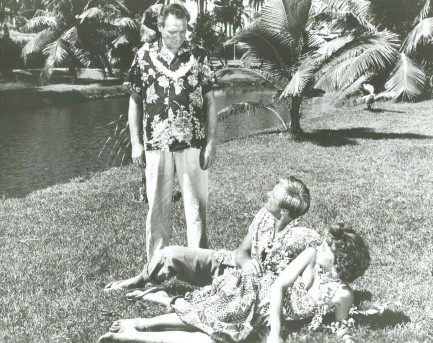 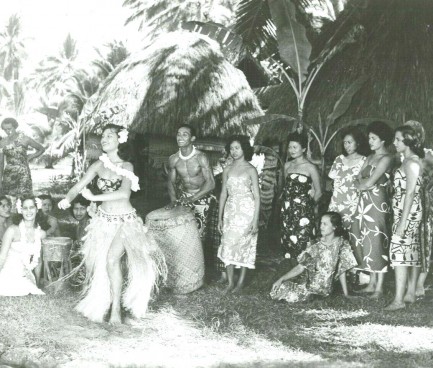 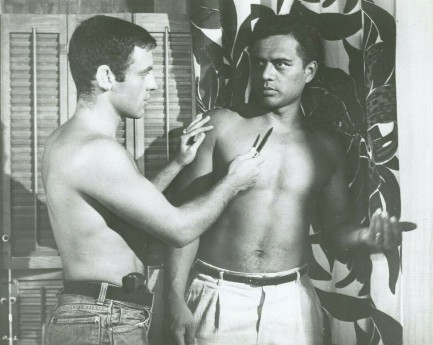 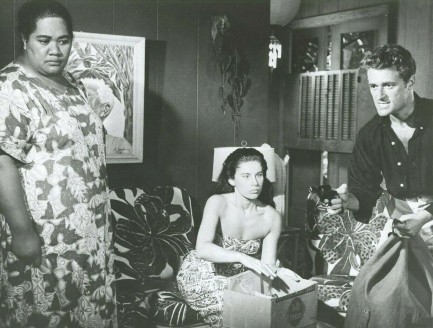 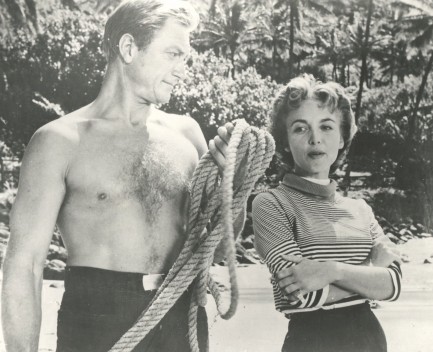 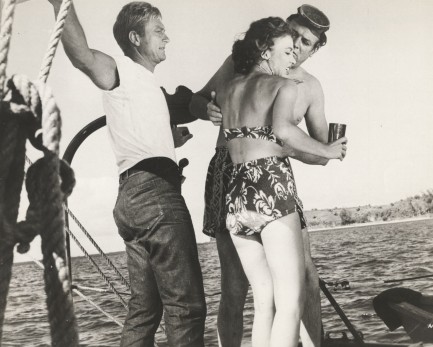 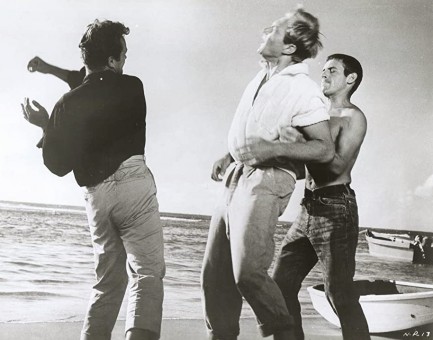 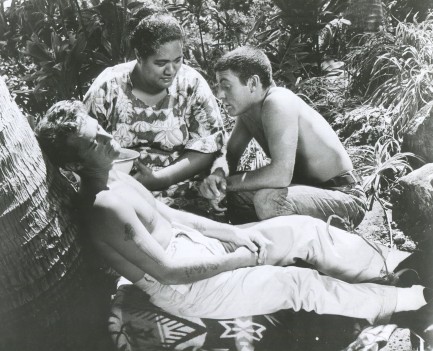 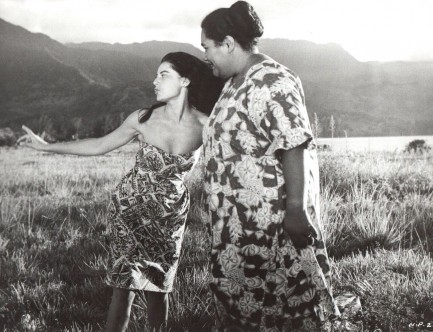 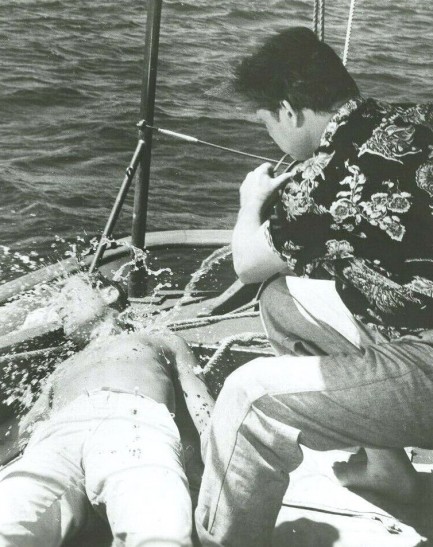 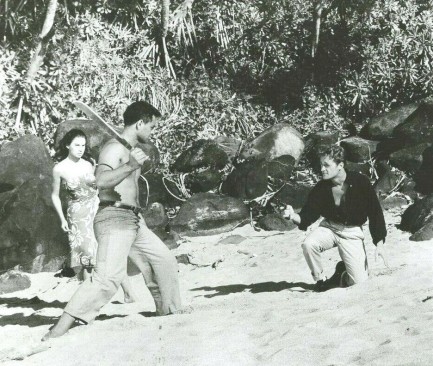
 This is right about when every dog person I've ever known starts to rethink their preferences. 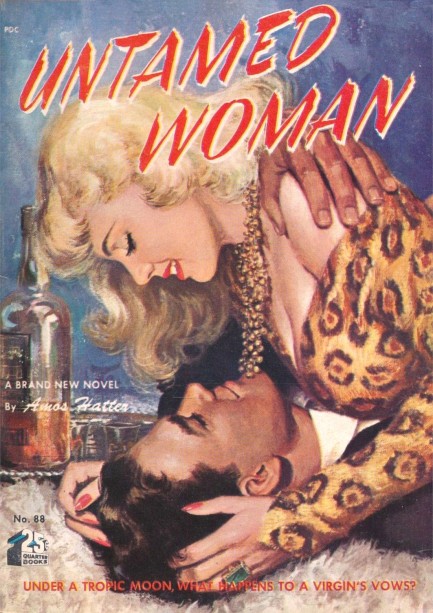
Amos Hatter entertained us very effectively with his 1952 Hawaiian romance Island Girl, and since we knew his 1951 novel Untamed Woman was set in the islands too, we grabbed it. Hatter, aka James W. Lampp, Ben West, et al, tells the story of laced up lawyer Natalie Brewster, who jets from Boston to paradise to get a contract signed by her firm's client Bill Grant. When her briefcase disappears at his bacchanalian luau she assumes he stole it to keep her from leaving so he can make advances toward her. After a time she isn't so sure he lifted it after all, but the missing briefcase does keep her there, and she gives in to Bill's overtures, and gets caught up in all of Hawaii's other distractions too.
Hatter is comfortable working within the setting, and punctuates his story with nice local color, as well as quirky humor. Our favorite sequence was a living room destroying fight between Natalie and her fierce rival Dorothy. Amazingly, of all the books we've read, that was the first knock-down drag-out—apart from the Modesty Blaise novels—that we've come across between two women. Hatter writes it well. The hatred is pure enough to set off Mauna Loa. The next day both Natalie and Dorothy are wrecked, which is what happens when you smash coffee tables and hurl vases at each other. The end of the book is a little rushed, and a little dumb, but if you want lightweight, male-oriented, 1950's sex adventure, Untamed Woman will get the job done. The cover on this, by the way, featuring a femme fatale in a leopard outfit, is uncredited.
 Touch a hot Stover and you'll get burned. 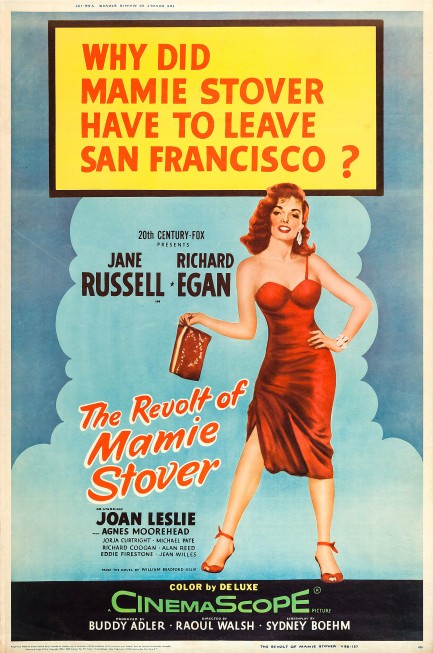
Above is a promo poster made for the Jane Russell drama The Revolt of Mamie Stover, which premiered in Honolulu today in 1956, and was sourced from William Bradford Huie's novel, a book we discussed at length some months back. The movie was directed by Raoul Walsh of Casablanca fame. He's properly credited on the above art, but for some reason on the second poster, which you'll find below, his name appears as Walsh Raoul. It's a weird mistake to get past so many studio eyes, but things like that happen, we guess. The U.S. art is uncredited, but the third poster, also below, was made for the film's British release and that was painted by Jock Hinchcliffe. He wasn't a noted stylist whose work is especially sought after today, but he did paint numerous posters, and he signed the piece below. Anyone who did that gets singled out here, because so few artists were credited by the studios.
Regarding the movie, needless to say, the challenging themes of Huie's novel were turned on their head by Hollywood. Mamie is no longer a racist toward Hawaiian islanders—in fact, the one islander character who gets to speak is bigoted against her. And she's no longer a prostitute but a hostess who induces men who frequent Honolulu's Bungalow Club to buy more booze and pay extra for private time. That private time takes place in a rattan decorated sideroom, but there's no bed evident. Instead there's a table and two chairs, so apparently men pay just to chat with Mamie, and the other women at the club. There's a sexual implication, but of the barest sort, because obviously Twentieth Century Fox could not have made a movie about Jane Russell prostituting herself 51,840 times—the exact number given in the book.
The Revolt of Mamie Stover is another example of suppressed sexual themes during the mid-century era, which is a big reason why we extend our purview at Pulp Intl. into erotic films and imagery—because in our era the previously unshown can be shown and openly examined. We've discussed this before. If you watch the movie, it's interesting to ponder the presumed maturity of book readers, who were asked point blank to consider a prolific prostitute the protagonist of the story, as opposed to cinemagoers, who were never presented with the possibility. In any case, the screen version of Stover, while not a sex worker, is at least a very knowing character, and Russell certainly has the sneer needed to pull off portraying a romantically cynical money worshipper determined to reach the top tax bracket no matter what it costs—her or others.
We figure anyone who has what it takes to get rich for simply, er, chatting with men deserves wealth, and indeed Mamie gets her money. That's not a spoiler, because it's never in doubt. It's part of the revolt—her resistance against forced membership in the underclass. The question is whether she can retain her newly gained higher status, and whether she can preserve the love she's stumbled upon along the way, because in American cinema moneyseeking characters must choose between their fortunes and their souls. That choice is supposed to supply the drama, but we think the movie is more interesting for its proto-feminist feel and class discussion. It's pretty good on all fronts, though, except that co-star Richard Egan is a bit of an empty shell. But he doesn't ruin it. How can he? He has Russell to carry him the entire ninety-three minutes.
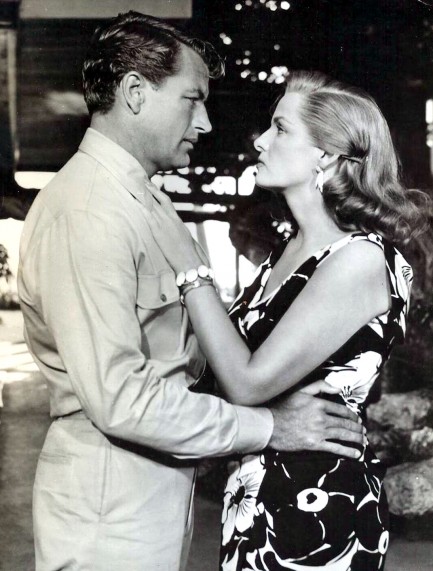 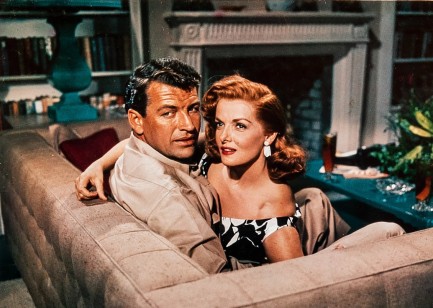 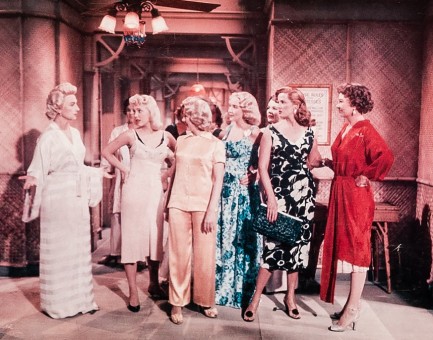 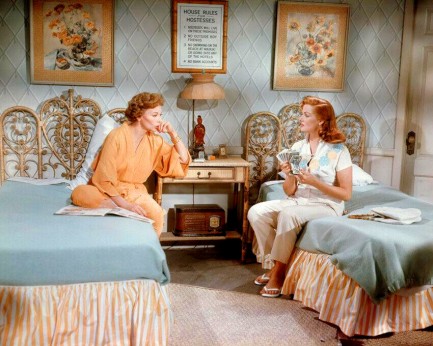 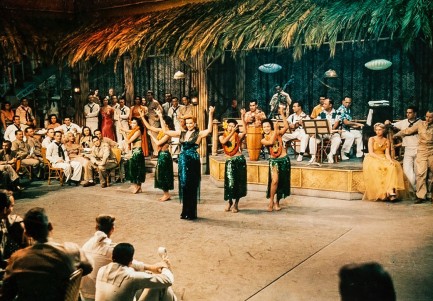 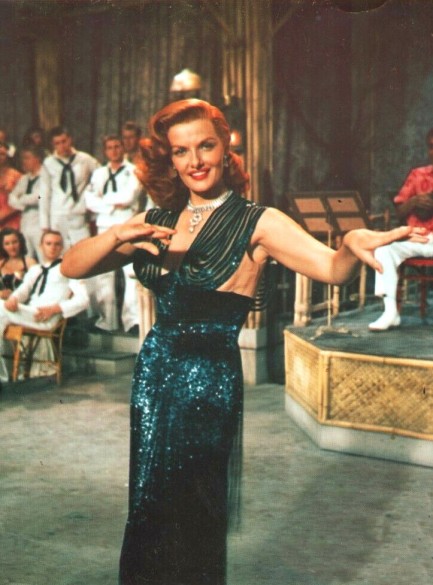 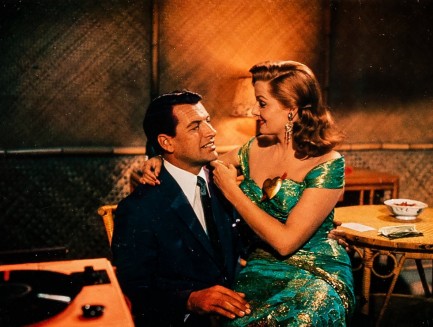 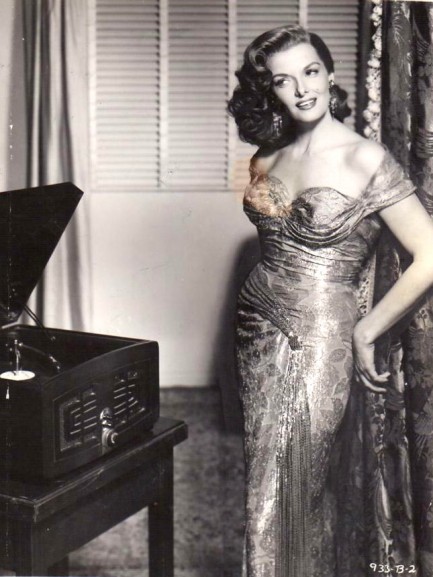 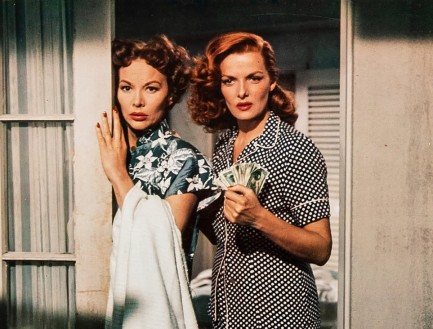    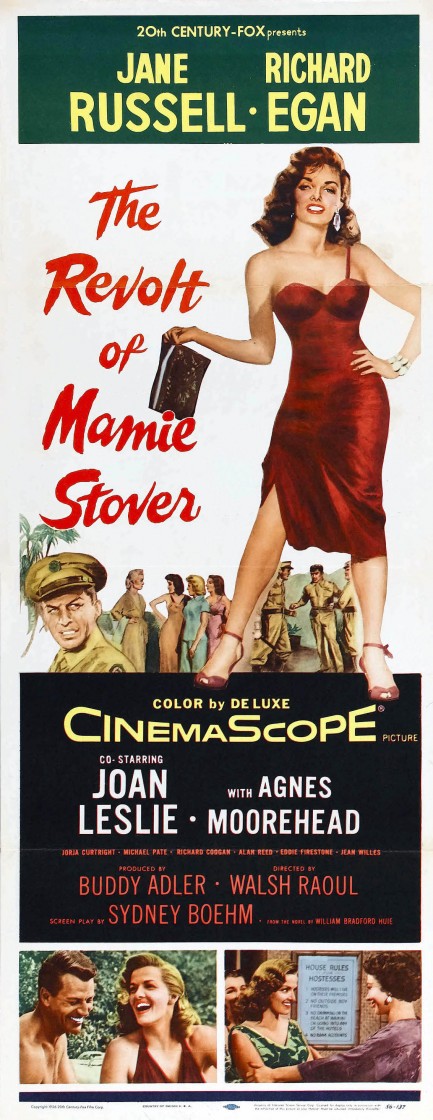 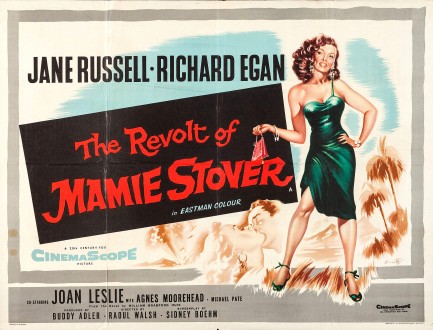 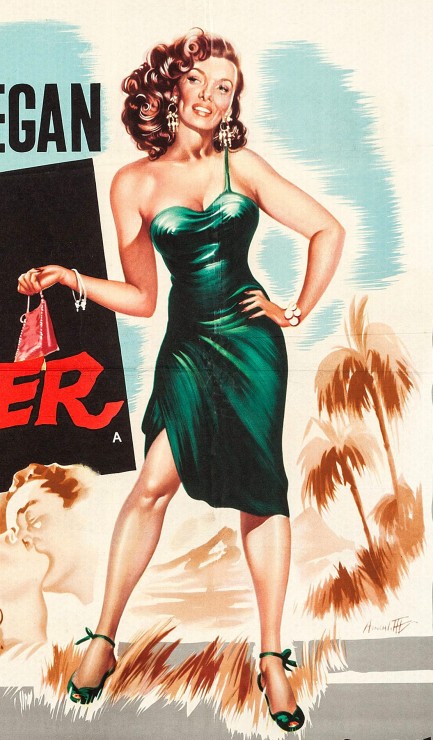
 She used the oldest game to become the newest player. 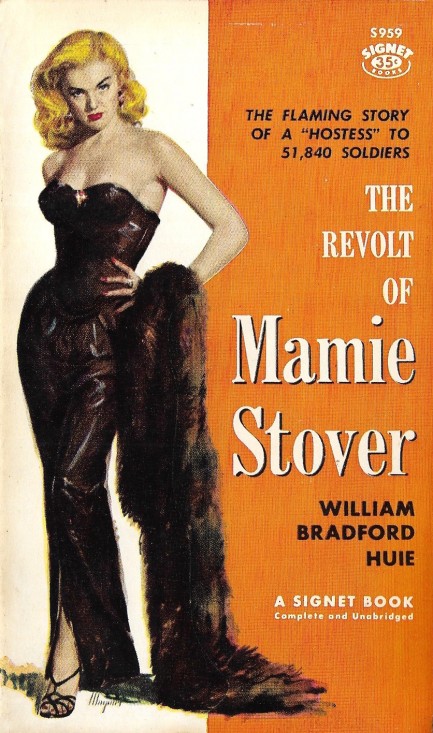
Once again art makes the sale, as we bought this copy of The Revolt of Mamie Stover thanks to its Robert Maguire cover. The blonde femme fatale is of course the Mamie of the title, an aspiring actress run out of Hollywood upon threat of death and booked onto a freighter headed for Honolulu, there to descend into the oldest profession and become a famed wartime prostitute known as Flaming Mamie. The story details her efforts to earn a mint, procure for herself a piece of Honolulu, and buy her way to respectability against terrific opposition from Oahu's Anglo bluebloods.
But there was something about the book that we couldn't put a finger on at first. If we'd read it in 1951 when it was originally published, it might have been clearer, we figured, but as it stood we weren't sure what underlying point Huie was trying to make until halfway through, when—aha!—we realized The Revolt of Mamie Stover is an allegory for the liberal assault against old world American values. At least that's the conclusion we reached. Just to be sure we double-checked on the internet and—aha!—allegory, liberal assault, and so forth.
However, like certain other mid-century novelists considered to be sociologically incisive at the time, Huie was working from incomplete information. The worth, order, and ever escalating prosperity he suggests industrious white men created out of primitive chaos are ending with a whimper under the assaults of climate change, soil depletion, de-industrialization, species extinction, tax evasion, unregulated financial speculation, and cynical war. Raping nature is simply a counterproductive enterprise. The science on that is settled. Trickle down economics don't trickle. That's settled too. Those industrious men built nothing that wasn't going to collapse anyway due to the laws of physics and corrupt economics.
But as we said, Huie couldn't have known that, so within his allegory America is going to hell in a handbasket due to the aforementioned liberal democratization. Or more to the point—give everyone equal rights, and the ungrateful bastards will actually use them to change things. Mamie Stover, barred from all the nice sectors of Honolulu because of her supposedly shameful profession, revolts against and smashes the prohibitions imprisoning her in second class citizenship—and as a result opens the door for native Hawaiians to burst their confines too and ruin whites-only Waikiki Beach.
Huie presents a choice between an orderly but racially repressive society and a disorderly democratic society, but he gets the reasons for disorder wrong. Disorder derives from deprivation, not democratization. Few people get bothered over what others achieve or possess if they feel themselves to be getting a fair shake. But make them feel they've been cheated and they'll assign blame. This is really what the industrious men figured out: the underclasses normally look upward for reasons their lives aren't improving, but it can be prevented if some of them can be made to feel they've been fucked over by others of them. If a racial element can be injected too, all the better. Once discord is established, even people who know better have to join the fight, if only to defend those unfairly under attack.
But while The Revolt of Mamie Stover is built around a moribund allegory, Mamie's personal story makes it a page turning book. You root for her—though it should noted she's no true protagonist. Huie gives readers a masterclass in racism, expressed repetitively and explicitly. Hawaiians, Japanese, Chinese, and other peoples you'd see around the islands are referred to mainly by slurs—not typical anti-Asian slurs, but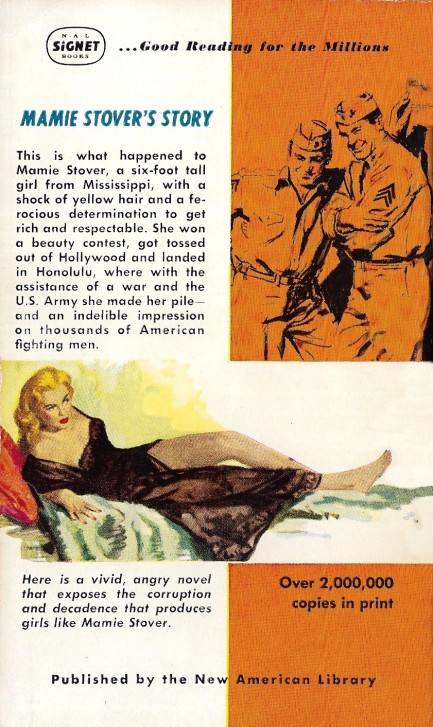 rather by that age-old slur for African Americans. Nice, right? It pops up, we'd estimate, fifty times in a short book. And Mamie is even more racist-mouthed than the rest. Once she gains access to the tony districts of town, she plans to punch down on all these undesirables. And she's going to enjoy it, she makes clear. She's prostituted herself to gain status—why should she care about anyone who wasn't willing to sacrifice as she did? rather by that age-old slur for African Americans. Nice, right? It pops up, we'd estimate, fifty times in a short book. And Mamie is even more racist-mouthed than the rest. Once she gains access to the tony districts of town, she plans to punch down on all these undesirables. And she's going to enjoy it, she makes clear. She's prostituted herself to gain status—why should she care about anyone who wasn't willing to sacrifice as she did?
A tale this ideological naturally makes you wonder what the author's personal beliefs were. Huie was complicated. While working as a journalist he involved himself in one of the most infamous racist murders of his era, and not in a good way. But he counted among his acquaintances Zora Neale Hurston and Roy Wilkins. He was probably not a bigot by 1950s standards, but in writing about class and race he was uncompromising, and his foundational assumptions about society were wrong. He could have written The Revolt of Mamie Stover with far less ugliness and it would have worked fine, but that never would have occurred to him. He saw ugly realism and reflected it. In that way he was a true writer. Before you read the book—if indeed you do—you'll have to consider that.
 In Hatter's novel Hawaii is blue in more ways than one. 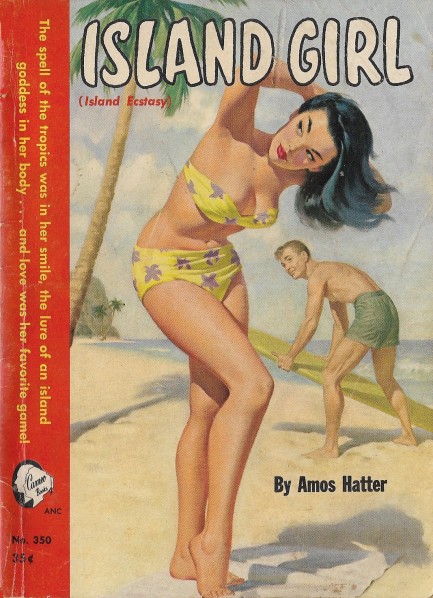
Amos Hatter, aka Ben West, aka James Lampp, originally published Island Girl as Island Ecstasy in 1952. Most copies of Island Girl are from a couple of years later, but somehow ours is also from 1952. The art, which is identical for both titles, is uncredited but very nice. The novel is about a Hawaiian beauty named Consuela Marlin, Connie for short, who takes a liking to a WASPish researcher named Jay Carter, and determines to win him over by any means necessary. Surprisingly for a 1952 novel, that leads to Connie bedding him—repeatedly.
Jay's a haole in Hawaiian lingo, a non-islander, which makes the romance a culture clash. It's also a clash of substance—Connie's relatable in every way, while Jay's goodhearted, but infuriatingly laissez-faire in his romantic attitudes. A complication soon arises in the form of a one percenter who lands on Oahu and decides he wants and is entitled to Connie. Forced kisses, stalkerish schemes, gaslighting, and browbeating are his tools, but this being a mid-century book, Hatter doesn't write him as a particularly bad guy, so much as a determined rival. What are the results of this shitty behavior? He gets what he wants—repeatedly.
These vintage sex dramas are strange as hell sometimes, but you know that going in, so you roll with it. Hatter's depiction of Consuela as independent yet submissive is dubious, but is in no way a surprise in a genre built around the supposed easy availability of women. We're just glad we didn't live during the era when men who were violent toward women were considered to be “a little forward” or “within their rights.” All that said, Island Girl is well written and worth a read, if for no other reason than the generational and sociological differences of the era it highlights.

|
 |

The headlines that mattered yesteryear.
2003—Hope Dies
Film legend Bob Hope dies of pneumonia two months after celebrating his 100th birthday. 1945—Churchill Given the Sack
In spite of admiring Winston Churchill as a great wartime leader, Britons elect
Clement Attlee the nation's new prime minister in a sweeping victory for the Labour Party over the Conservatives. 1952—Evita Peron Dies
Eva Duarte de Peron, aka Evita, wife of the president of the Argentine Republic, dies from cancer at age 33. Evita had brought the working classes into a position of political power never witnessed before, but was hated by the nation's powerful military class. She is lain to rest in Milan, Italy in a secret grave under a nun's name, but is eventually returned to Argentina for reburial beside her husband in 1974. 1943—Mussolini Calls It Quits
Italian dictator Benito Mussolini steps down as head of the armed forces and the government. It soon becomes clear that Il Duce did not relinquish power voluntarily, but was forced to resign after former Fascist colleagues turned against him. He is later installed by Germany as leader of the Italian Social Republic in the north of the country, but is killed by partisans in 1945.
|

|
|

It's easy. We have an uploader that makes it a snap. Use it to submit your art, text, header, and subhead. Your post can be funny, serious, or anything in between, as long as it's vintage pulp. You'll get a byline and experience the fleeting pride of free authorship. We'll edit your post for typos, but the rest is up to you. Click here to give us your best shot.

|
|








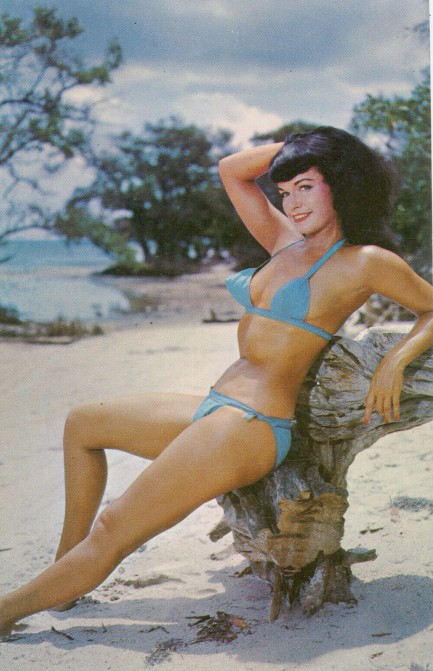
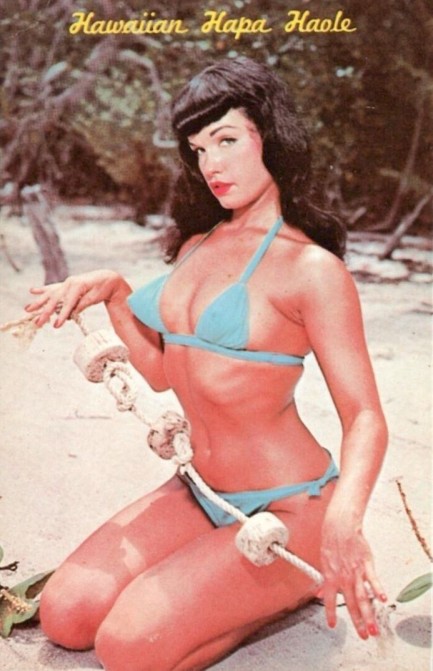
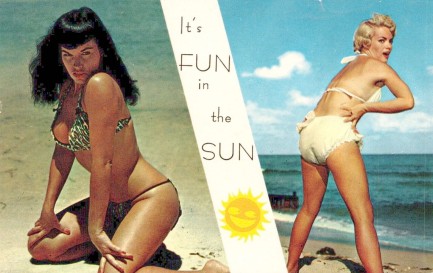
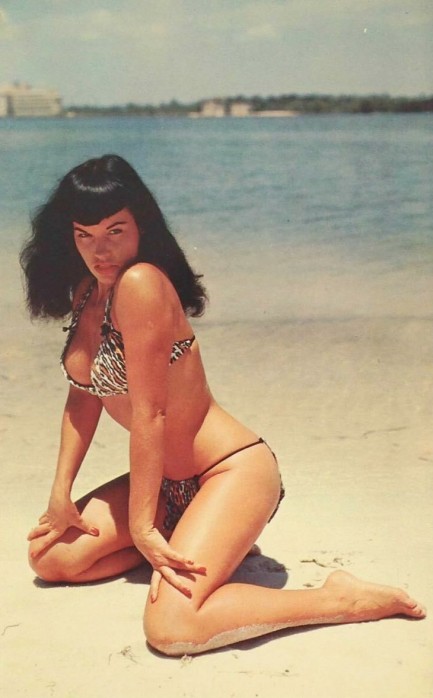

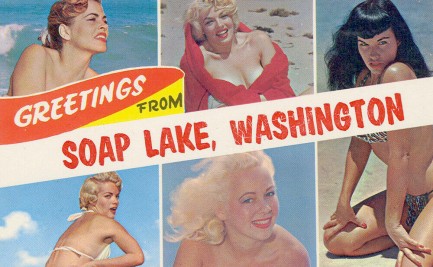

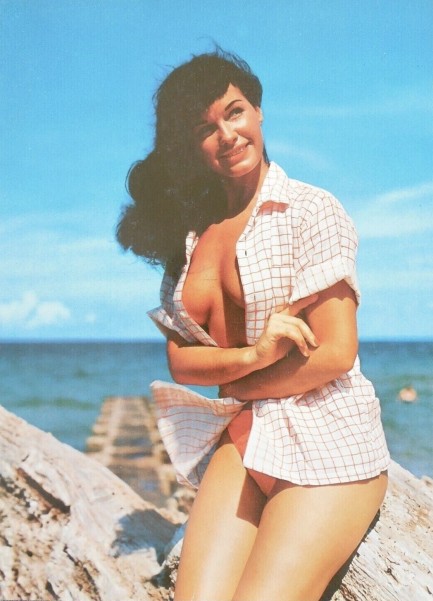
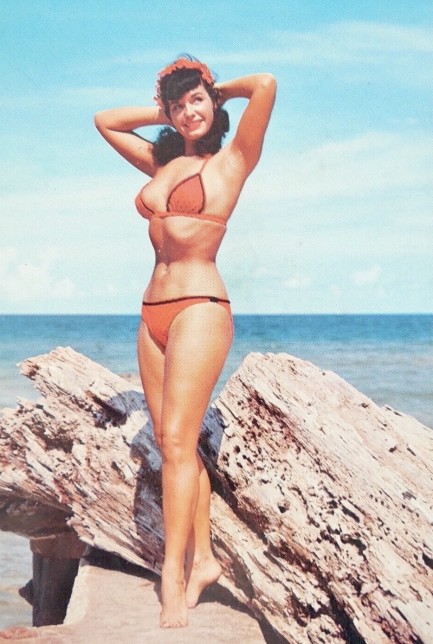
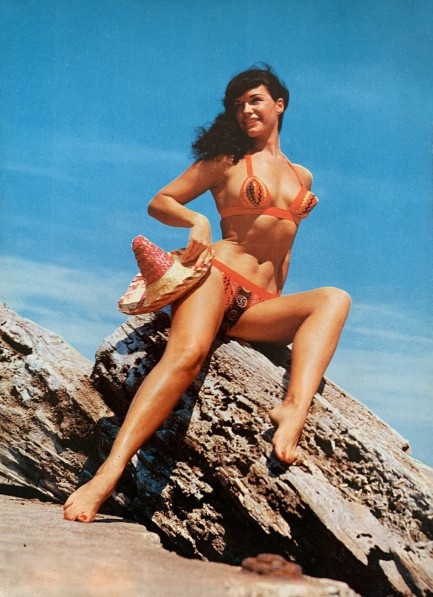
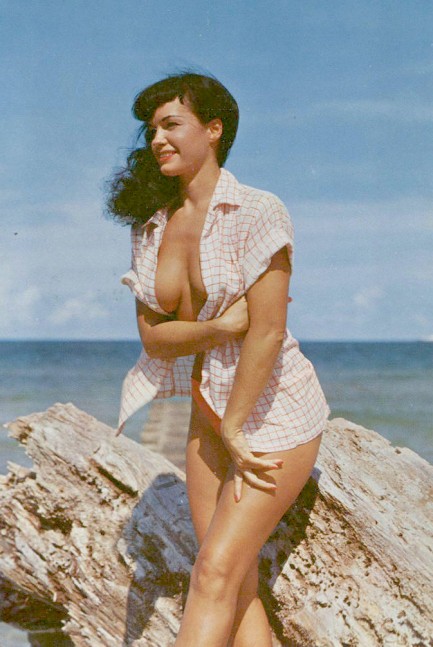

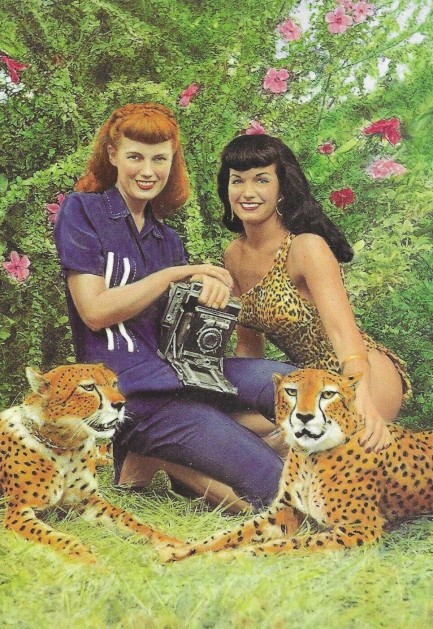





















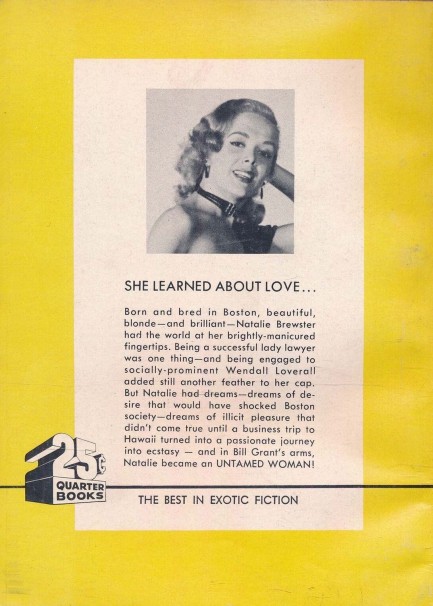
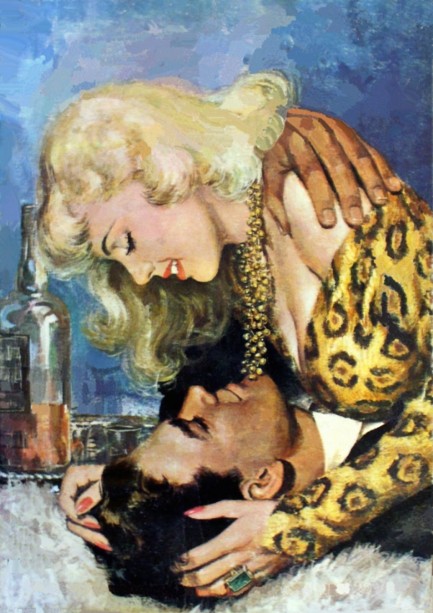



















 rather by that age-old slur for African Americans. Nice, right? It pops up, we'd estimate, fifty times in a short book. And Mamie is even more racist-mouthed than the rest. Once she gains access to the tony districts of town, she plans to punch down on all these undesirables. And she's going to enjoy it, she makes clear. She's prostituted herself to gain status—why should she care about anyone who wasn't willing to sacrifice as she did?
rather by that age-old slur for African Americans. Nice, right? It pops up, we'd estimate, fifty times in a short book. And Mamie is even more racist-mouthed than the rest. Once she gains access to the tony districts of town, she plans to punch down on all these undesirables. And she's going to enjoy it, she makes clear. She's prostituted herself to gain status—why should she care about anyone who wasn't willing to sacrifice as she did?

